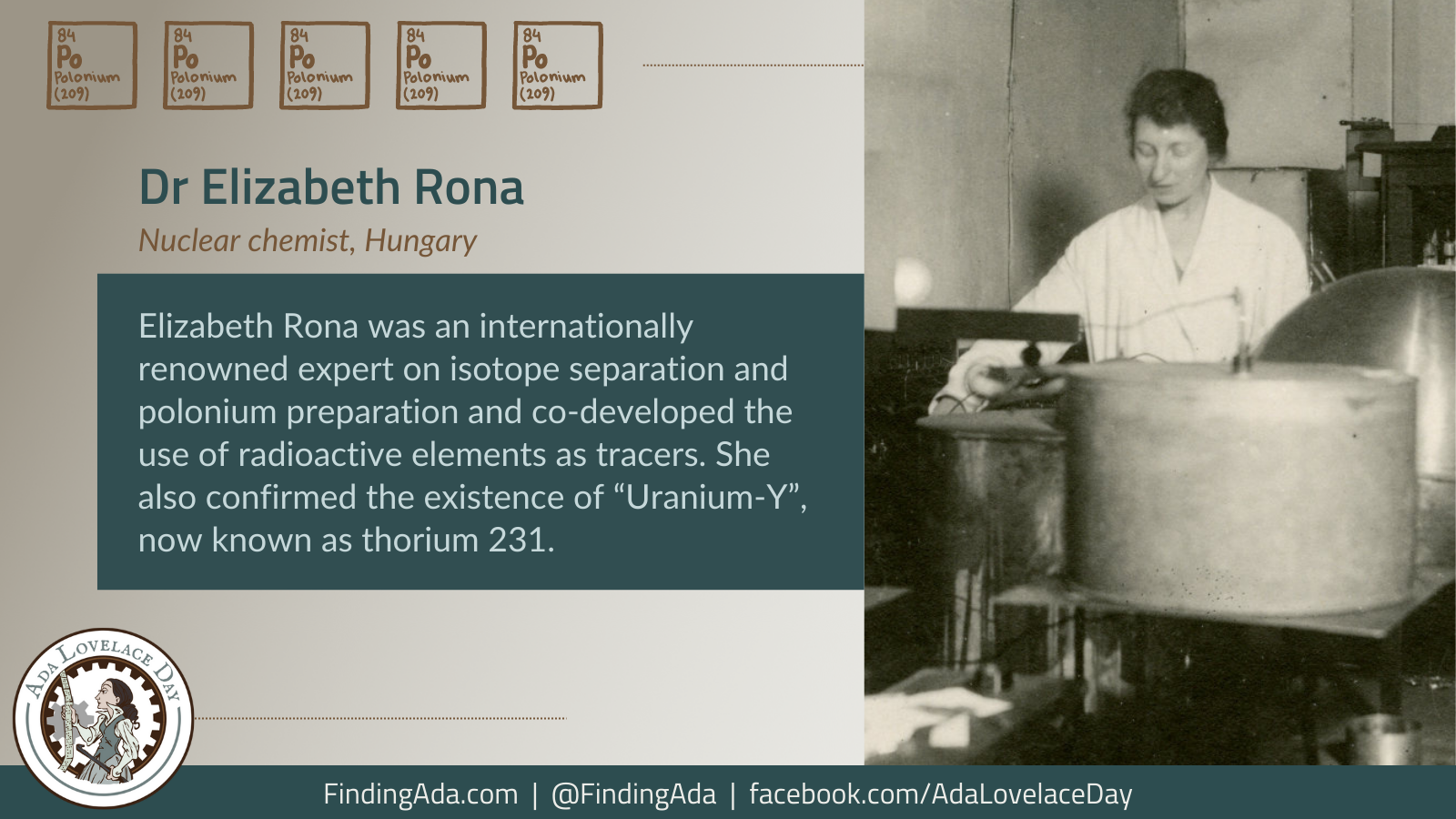
Dr Elizabeth Rona
Dr Elizabeth Rona was a nuclear chemist who became an internationally renowned expert on isotope separation and polonium preparation. She also confirmed the existence of “Uranium-Y”, known as thorium 231.
Rona was born in 1890 in Budapest. She studied chemistry, geochemistry, and physics at the Philosophy Faculty at the University of Budapest, earning her PhD in 1912. After graduation she worked at the Kaiser Wilhelm Institute, Karlsruhe University and then University College London before returning to Budapest when World War I started.
She joined Budapest’s Chemical Institute, working on the diffusion of radon in water before being asked to investigate a new element known as Uranium-Y, ie thorium 231, which she successfully separated from other elements. She confirmed that it emitted beta radiation and had a half-life of 25 hours. Her work formed the basis of later mass spectrography and heavy water studies.
She worked with chemist George von Hevesy, using radioactive elements as tracers so that they could more easily study chemical reactions. They studied the diffusion of radioactive tracers through different materials, gathering the data required to calculate an atom’s size. Von Hevesy eventually won the Nobel Prize for his work on tracers, and they are now used to help diagnose cancer, heart disease and other conditions.
She became the first woman to teach chemistry at a university level in Hungary, but the communist invasion of Hungary and the subsequent anti-communist White Terror made life and work there untenable. She moved to the Kaiser Wilhelm Institute to work with Otto Hahn on separating ionium (now thorium 230) from uranium until she was transferred to a more practical role in the Textile Fibre Institute. She returned to Hungary in 1923, to work in a textile factory, but disliked the work and left to join the Institute for Radium Research of Vienna in 1924.
Rona learnt how to separate polonium from Irène Joliot-Curie in Paris, returning to the Radium Institute as a well-respected expert whose skills were much in demand. She worked with several collaborators, and her work with Berta Karlik on the half-lives of uranium, thorium and actinium decay, radiometric dating, and alpha particles won them both the Austrian Academy of Sciences Haitinger Prize in 1933. She returned to Paris to work with Joliot-Curie, who died not long after. Rona herself became ill, but later went to Vienna to share what she’d learnt with a group of other researchers who were working on a wide variety of research projects.
She spent some of World War II working in Sweden and Norway, but returned to Budapest to work at the Radium-Cancer Hospital where she prepared radium for medical use.
In 1941, however, she fled to the USA, eventually finding a teaching job at Trinity College in Washington, DC before being awarded a Carnegie Fellowship, and she began studying radium seawater and sediments at the Geophysical Laboratory of the Carnegie Institute. She assisted the Manhattan Project, giving them her method for extracting polonium.
She continued her work after the war, at the United States Atomic Energy Commission and then the Oak Ridge Institute of Nuclear Studies, where she worked as a chemist and senior scientist in nuclear studies. She discovered that uranium levels in seawater are globally constant, but that thorium collects in sediments, so the decay of uranium to thorium can be used to date core samples. This method of dating is still used today.
She continued working despite two retirements, first from Oak Ridge and then from the University of Miami, returning to Tennessee in the 1970s.
Rona became aware of the dangers of radium early in her career, but her warnings of the dangers and requests for protective equipment such as gas masks were ignored and she had to supply her own. She managed to avoid radiation exposure, however, and survived at least two lab explosions.
She died in 1981, aged 91.
Further Reading
- Elizabeth Rona, Wikipedia
- Overlooked No More: Elizabeth Rona, Pioneering Scientist Amid Dangers of War, Veronique Greenwood, The New York Times, 28 August 2019
- Elizabeth Rona, the wandering polonium woman, changed radiation science forever, Brittney G. Borowiec, Massive Science, 29 December 2019